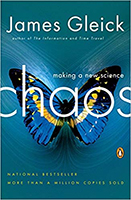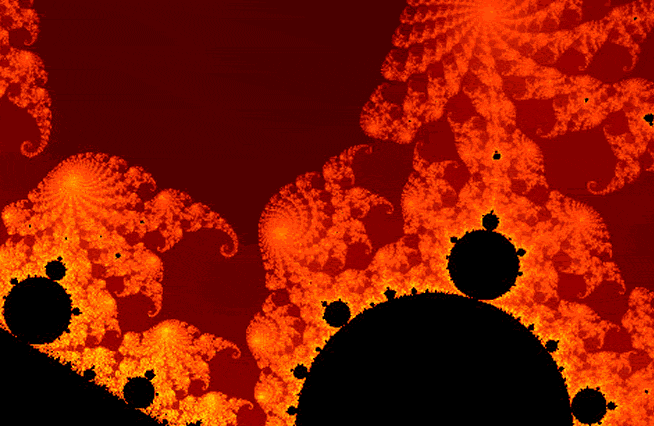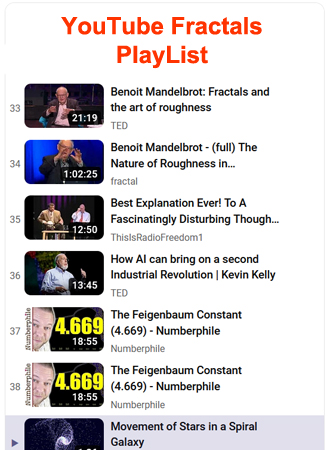
FROM THE WEBSITE "SCIENCE CLARIFIED": "A fractal is a geometric figure with two special properties. First, it is irregular, fractured, fragmented, or loosely connected in appearance. Second, it is self-similar; that is, the figure looks much the same no matter how far away or how close up it is viewed. The term fractal was invented by Polish French mathematician Benoit Mandelbrot (1924– 2010) in 1975. He took the word from the Latin word fractus, which means "broken." The idea behind fractals is fairly simple and obvious when explained. But the mathematics used to develop those ideas is not so simple. Most objects in nature do not have simple geometric shapes. Clouds, trees, and mountains, for example, usually do not look like circles, triangles, or pyramids. Instead, they can best be described as fractals. Fractals are used by geologists to model the meandering paths of rivers and the rock formations of mountains; by botanists to model the branching patterns of trees and shrubs; by astronomers to model the distribution of mass in the universe; by physiologists to model the human circulatory system; by physicists and engineers to model turbulence in fluids; by economists to model the stock market and world economics." [CHP editor's note: And by movie special effects and CGI specialists to create natural-looking artificial landscapes, and artists like Janet Parke (see image above) to produce gorgeous abstract images.]
 NOVA Video: "Hunting the Hidden Dimension." See below. This is the best introduction to fractals we've seen (and the highest-quality-video version). One-hour video divided into five chapters. This documentary highlights a host of filmmakers, fashion designers, physicians, and other researchers who are using fractal geometry to innovate and inspire. Based on the fourth chapter of James Gleick's book, Chaos: Making a New Science (New York: Viking, 1987). Made by Kikkim Media. Original PBS Broadcast Date: October 28, 2008. Click on the picture below to watch the video on YouTube.
NOVA Video: "Hunting the Hidden Dimension." See below. This is the best introduction to fractals we've seen (and the highest-quality-video version). One-hour video divided into five chapters. This documentary highlights a host of filmmakers, fashion designers, physicians, and other researchers who are using fractal geometry to innovate and inspire. Based on the fourth chapter of James Gleick's book, Chaos: Making a New Science (New York: Viking, 1987). Made by Kikkim Media. Original PBS Broadcast Date: October 28, 2008. Click on the picture below to watch the video on YouTube.
ABOVE: The full-length video in excellent resolution.
Other postings:
https://www.youtube.com/watch?v=Kkf_M9-pDTw - TRAILER - Great-quality video
https://vimeo.com/77925283 - Full video - decent quality video
https://www.youtube.com/watch?v=V4Cx9gz_i6E - Full - OK video
https://www.dailymotion.com/video/x10et38 - Full - rough video
Most of the links below point to scientific discussions, but many point to fractal art, and others to fractals as used in practical applications—ecology, astrophysics, communications, materials engineering, etc. But they are all enlightening and, in many cases, very beautiful.
Michael Frame, Benoit Mandelbrot, and Nial Neger, Fractal Geometry (Yale University, December 3, 2004)
Truly amazing. This is an on-line collection of pages meant to support a first course in fractal geometry for students without especially strong mathematical preparation, or any particular interest in science. In includes a vast array of practical explanations and other resources, working Java applications, etc., covering a vast array of applications of fractal theory.
https://users.math.yale.edu/public_html/People/frame/Fractals/
Internet Resources for Fractals (an extensive web bibliography with links)
http://math.fullerton.edu/mathews/c2003/FractalBib/Links/FractalBib_lnk_1.html
What is a fractal?
http://www.laubender.de/fractaline/what_is_a_fractal.htm
The Fractal Geometry of the Mandelbrot Set
http://math.bu.edu/DYSYS/FRACGEOM/FRACGEOM.html
A Mandelbrot set animation from http://members.rogers.com/ender.othc/images/mandelzoom.mpeg
And the same set created mathematically via a Java applet (pretty neat!)
http://www.thorsen.priv.no/services/mandelbrot/
Fractal bacterial growth
http://classes.yale.edu/Fractals/Panorama/Biology/Bacteria/Bacteria2.html
Fourth International Symposium: Fractals in Biology and Medicine, Ascona, March 10-14, 2004
http://www.fractals.issi.cerfim.ch/
Fractals in Human Physiology
http://classes.yale.edu/fractals/Panorama/Biology/Physiology/Physiology.html
About fractals
http://www.infinite-art.com/aboutfractals.html
How fractal art images are made
http://www.infinite-art.com/aboutfractals.html
Fractals, in Layman's Terms
http://www.fractalus.com/info/layman.htm
Fractal Art Images
http://perso.wanadoo.fr/imagitheque/
More fractal images
http://gnofract4d.sourceforge.net/gallery1.html
Fractal Easter-egg designs (these images are created entirely by a set of mathematical parameters, with no artistic post-processing).
http://www.parkenet.org/jp/ufeggs.html
How artists actually do this stuff—part of a tutorial on a program called UltraFractal).
http://www.parkenet.org/jp/ufscratch.html

| Return to top |
|---|

